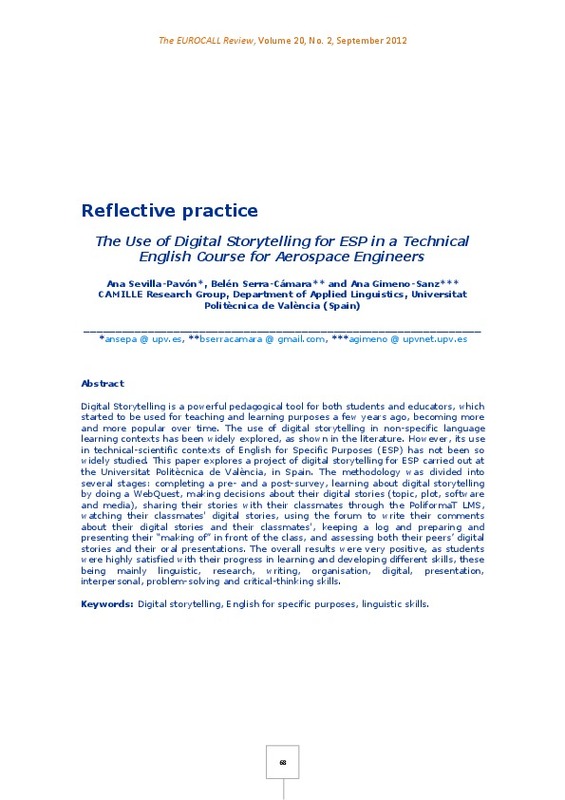JavaScript is disabled for your browser. Some features of this site may not work without it.
Buscar en RiuNet
Listar
Mi cuenta
Estadísticas
Ayuda RiuNet
Admin. UPV
The Use of Digital Storytelling for ESP in a Technical English Course for Aerospace Engineers
Mostrar el registro sencillo del ítem
Ficheros en el ítem
| dc.contributor.author | Sevilla-Pavón, Ana
|
es_ES |
| dc.contributor.author | Serra-Cámara, Belén
|
es_ES |
| dc.contributor.author | Gimeno-Sanz, Ana
|
es_ES |
| dc.date.accessioned | 2019-02-26T07:35:24Z | |
| dc.date.available | 2019-02-26T07:35:24Z | |
| dc.date.issued | 2012-09-29 | |
| dc.identifier.uri | http://hdl.handle.net/10251/117339 | |
| dc.description.abstract | [EN] Digital Storytelling is a powerful pedagogical tool for both students and educators, which started to be used for teaching and learning purposes a few years ago, becoming more and more popular over time. The use of digital storytelling in non-specific language learning contexts has been widely explored, as shown in the literature. However, its use in technical-scientific contexts of English for Specific Purposes (ESP) has not been so widely studied. This paper explores a project of digital storytelling for ESP carried out at the Universitat Politècnica de València, in Spain. The methodology was divided into several stages: completing a pre- and a post-survey, learning about digital storytelling by doing a WebQuest, making decisions about their digital stories (topic, plot, software and media), sharing their stories with their classmates through the PoliformaT LMS, watching their classmates' digital stories, using the forum to write their comments about their digital stories and their classmates', keeping a log and preparing and presenting their “making of” in front of the class, and assessing both their peers’ digital stories and their oral presentations. The overall results were very positive, as students were highly satisfied with their progress in learning and developing different skills, these being mainly linguistic, research, writing, organisation, digital, presentation, interpersonal, problem-solving and critical-thinking skills. | es_ES |
| dc.language | Inglés | es_ES |
| dc.publisher | Universitat Politècnica de València | |
| dc.relation.ispartof | The EuroCALL Review | |
| dc.rights | Reconocimiento - No comercial - Sin obra derivada (by-nc-nd) | es_ES |
| dc.subject | Digital storytelling | es_ES |
| dc.subject | English for specific purposes | es_ES |
| dc.subject | Linguistic skills | es_ES |
| dc.title | The Use of Digital Storytelling for ESP in a Technical English Course for Aerospace Engineers | es_ES |
| dc.type | Artículo | es_ES |
| dc.date.updated | 2019-02-25T09:02:48Z | |
| dc.identifier.doi | 10.4995/eurocall.2012.11379 | |
| dc.rights.accessRights | Abierto | es_ES |
| dc.contributor.affiliation | Universitat Politècnica de València. Escuela Técnica Superior de Ingeniería del Diseño - Escola Tècnica Superior d'Enginyeria del Disseny | es_ES |
| dc.contributor.affiliation | Universitat Politècnica de València. Departamento de Lingüística Aplicada - Departament de Lingüística Aplicada | es_ES |
| dc.description.bibliographicCitation | Sevilla-Pavón, A.; Serra-Cámara, B.; Gimeno-Sanz, A. (2012). The Use of Digital Storytelling for ESP in a Technical English Course for Aerospace Engineers. The EuroCALL Review. 20(2):68-79. https://doi.org/10.4995/eurocall.2012.11379 | es_ES |
| dc.description.accrualMethod | SWORD | es_ES |
| dc.relation.publisherversion | https://doi.org/10.4995/eurocall.2012.11379 | es_ES |
| dc.description.upvformatpinicio | 68 | es_ES |
| dc.description.upvformatpfin | 79 | es_ES |
| dc.type.version | info:eu-repo/semantics/publishedVersion | es_ES |
| dc.description.volume | 20 | |
| dc.description.issue | 2 | |
| dc.identifier.eissn | 1695-2618 | |
| dc.description.references | Bruner J. (2003). Making Stories: Law, Literature, Life. Cambridge, MA: Harvard University Press. | es_ES |
| dc.description.references | Bruner, J. (1996). The Culture of Education. Cambridge, MA: Harvard University Press. | es_ES |
| dc.description.references | Bruner, J. S. (1987). Life as narrative. Social Research, 54: 1-17. | es_ES |
| dc.description.references | Robin, B. R. (2012). The Educational Uses of Digital Storytelling, http://digitalliteracyintheclassroom.pbworks.com/f/Educ-Uses-DS.pdf. Last accessed 29/06/2012. | es_ES |
| dc.description.references | Council of Europe (2001). Common European Framework of Reference for Languages. Cambridge: Cambridge University Press. | es_ES |
| dc.description.references | Lowenthal, P. R. (2009). Digital storytelling: An emerging institutional technology? In K. McWilliam & J. Hartley (Eds.), Story circle: Digital storytelling around the world. Malden, MA: Wiley-Blackwell, pp. 252-259. https://doi.org/10.1002/9781444310580.ch18 | es_ES |
| dc.description.references | Lowenthal, P. R. y Dunlap, J. C. (2010). From pixel on a screen to real person in your students' lives: Establishing social presence using digital storytelling. Internet and Higher Education, No. 13, pp. 70-72. https://doi.org/10.1016/j.iheduc.2009.10.004 | es_ES |
| dc.description.references | Rex, L. Al, Murnen, T., Hobbs, J., y McEachen, D. (2002). Teachers' pedagogical stories and the shaping of classroom participation: "The Dancer" and "Graveyard Shift at the 7-11". American Education Research Journal, 39(3), pp. 765-796. https://doi.org/10.3102/00028312039003765 | es_ES |
| dc.description.references | Sevilla-Pavón, A., Martínez-Sáez, A., & Siquiera-Rocha, J. M. (2011). Self-assessment and Tutor Assessment in Online Language Learning Materials: InGenio FCE Online Course & Tester. In S. Thouësny & L. Bradley (Eds.), Second Language Teaching and Learning with Technology. Dublin: Research-publishing.net, pp.45-69. https://doi.org/10.14705/rpnet.2011.000006 | es_ES |
| dc.description.references | Shank, R. C. (1990). Tell me a story: Narrative and intelligence. Evanston, IL: Northwestern University Process. | es_ES |
| dc.description.references | Zull, J. (2002) The Art of Changing the Brain. Sterling, VA: Stylus Publishing. | es_ES |







![HTML file [HTML]](/themes/UPV/images/html.png)

